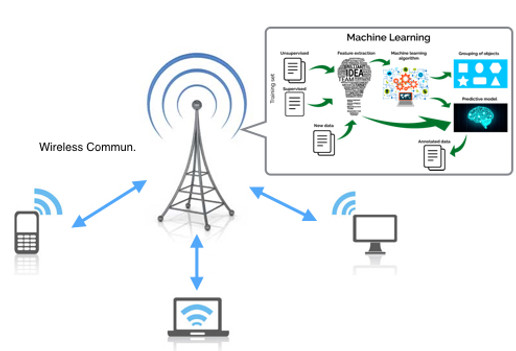
The recent revival of artificial intelligence (AI) is revolutionizing almost every branch of science and technology. Given the ubiquitous smart mobile gadgets and Internet of Things (IoT) devices, it is expected that a majority of intelligent applications will be deployed at the edge of wireless networks. This trend has generated strong interests in realizing an “intelligent edge” to support AI-enabled applications at various edge devices. Accordingly, a new research area, called edge learning, emerges, which crosses and revolutionizes two disciplines: wireless communication and machine learning. A major theme in edge learning is to overcome the limited computing power, as well as limited data, at each edge device. This is accomplished by leveraging the mobile edge computing (MEC) platform and exploiting the massive data distributed over a large number of edge devices. In such systems, learning from distributed data and communicating between the edge server and devices are two critical and coupled aspects, and their fusion advocates a new set of design principle for wireless communication in edge learning, collectively called learning-driven communication as introduced in [ELC1].
The vision is further illustrated in the following three key topics:
-
Learning-driven signal encoding for high-speed data-feature transmission [ELC2]
-
Importance-aware resource allocation for agile intelligence acquisition [ELC3]
-
Computation-oriented multiple access for ultra-fast data aggregation [ELC4]
On the other hand, recent breakthroughs in machine learning have motivated researchers to apply relevant techniques for bringing intelligence to communication systems and networks. Potentially, machine learning techniques can be exploited to either enhance the individual communications functional blocks (e.g., synchronization, channel estimation and equalization) or even replacing the traditional modularized architecture with an all-in-one integrated solution directly targeting the end-to-end performance. Our group contributes to this emerging area by developing intelligent communications system design via integrating cutting-edge learning techniques and wireless communications theory in the same vein. Our initial work on this area includes the application of statistical inference to tackle the primitive hardware and signal processing limitations of backscatter sensors [ELC5], and the application of machine learning on Grassmann manifold to facilitate automatic constellation recognization and non-coherent MIMO signal recovery [ELC6].
Recently, our group also developed an interest in an emerging trend in machine learning society that advocates geometry-awareness embedding in the learning algorithm design. Our research in this field has led to a tutorial paper [ELC7] which introduces a particularly new area along with the trend, called Grassmannian learning. It is a new machine learning paradigm that involves subspace-structured features, Grassmannian metrics or Grassmannian-constrained objective functions. The new learning paradigm finds a wide range of signal-processing applications in the areas of computer vision, natural language processing, and wireless communications and thus has a broad impact.
[ELC1] G. Zhu, D. Liu, Y, Du, C. You, J. Zhang, and K. Huang, "Towards an Intelligent Edge: Wireless Communication Meets Machine Learning”, submitted to IEEE for possible publication. (ArXiv)
[ELC2] Y. Du and K. Huang, "Fast Analog Transmission for High-Mobility Wireless Data Acquisition in Edge Learning", accepted to IEEE Wireless Commun. Lett.. (ArXiv)
[ELC3] D. Liu, G. Zhu, J. Zhang, and K. Huang, "Wireless Data Acquisition for Edge Learning: Importance Aware Retransmission". (ArXiv)
[ELC4] G. Zhu, Y. Wang, and K. Huang, "Broadband Analog Aggregation for Low-Latency Federated Edge Learning,” submitted to IEEE for possible publication. (ArXiv)
[ELC5] G. Zhu, S.-W. Ko and K. Huang, "Inference from Randomized Transmissions by Many Backscatter Sensors," IEEE Trans. on Wireless Commun., vol. 17, no. 5, pp 3111-3127, May 2018. (ArXiv)
[ELC6] Y. Du, G. Zhu, J. Zhang, and K. Huang, "Automatic Recognition of Space-Time Constellations by Learning on the Grassmann Manifold", IEEE Trans. on Signal Process., vol. 66, no. 22, pp. 6031-6046, Nov. 2018.(ArXiv)
[ELC7] J. Zhang, G. Zhu, R. Heath Jr., and K. Huang, “Grassmannian Learning: Embedding Geometry Awareness in Shallow and Deep Learning,” submitted to IEEE for possible publication. (ArXiv)
